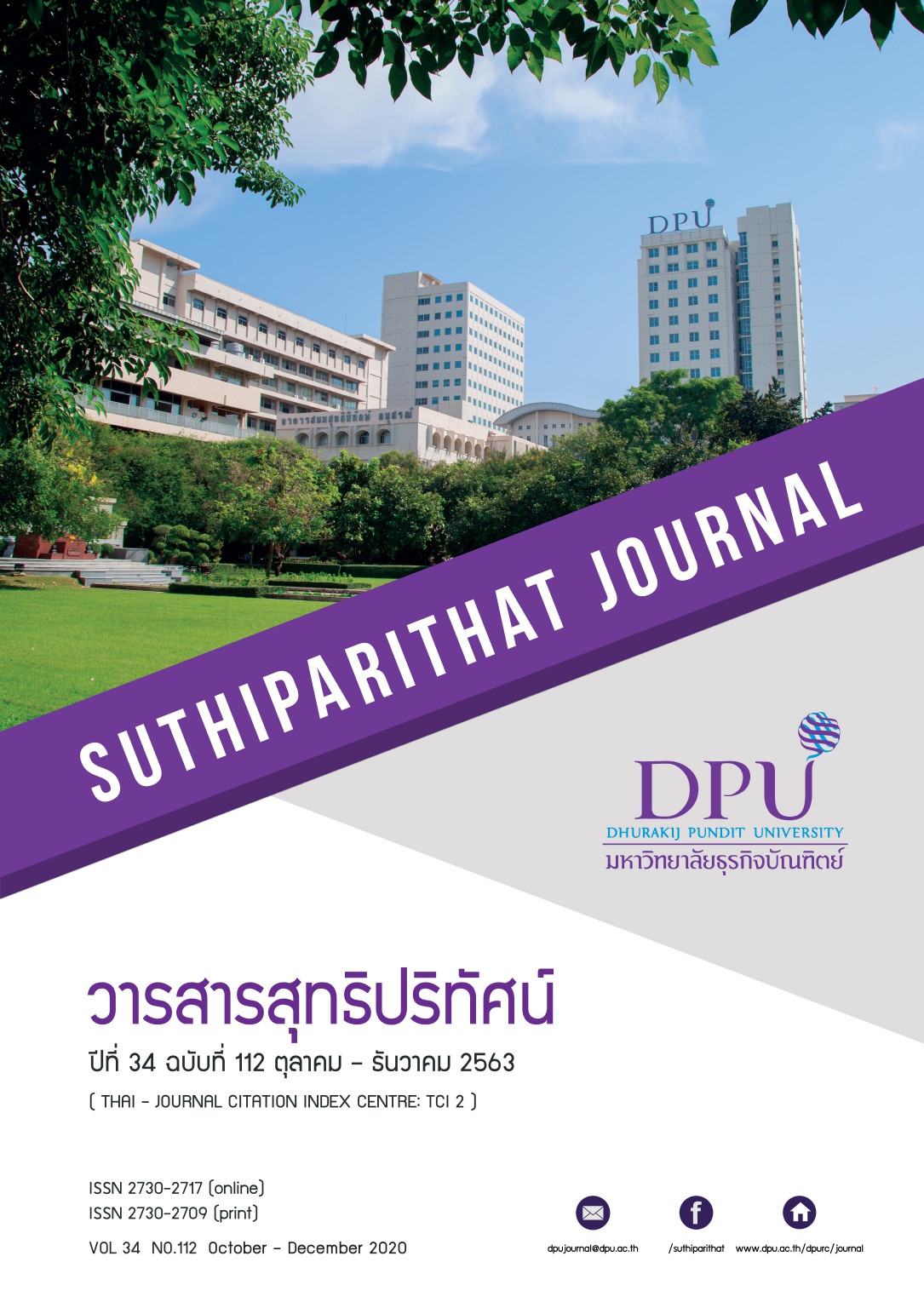ผลกระทบของประสิทธิภาพทางเทคนิค และการใช้ประโยชน์สินทรัพย์ทางการเงิน ต่อผลการดำเนินงานด้านการเงิน และมูลค่าองค์กรตามราคาตลาด ของบริษัทจดทะเบียนในตลาดหลักทรัพย์แห่งประเทศไทย กลุ่มสถาบันการเงิน
คำสำคัญ:
ประสิทธิภาพทางเทคนิค, การใช้ประโยชน์สินทรัพย์ทางการเงิน, ผลการดำเนินงานด้านการเงิน, มูลค่าองค์กรตามราคาตลาดบทคัดย่อ
การวิจัยในครั้งนี้มีวัตถุประสงค์เพื่อศึกษาผลกระทบของประสิทธิภาพทางเทคนิค และการใช้ประโยชน์สินทรัพย์ทางการเงินที่มีต่อ ผลการดำเนินงานด้านการเงิน และมูลค่าองค์กรตามราคาตลาด ซึ่งเป็นการวิจัยเชิงปริมาณ ตัวอย่างการวิจัยเชิงปริมาณ คือสถาบันการเงินที่จดทะเบียนในตลาดหลักทรัพย์ประเทศไทย จำนวน 200 ตัวอย่าง สถิติที่ใช้ในการวิเคราะห์ข้อมูลได้แก่ สถิติเชิงอนุมาน ด้วยการวิเคราะห์เส้นทาง (Path Analysis) โดยการใช้โปรแกรม AMOS ผลการวิจัยพบว่า (1) ประสิทธิภาพทางเทคนิคมีอิทธิพลทางตรงต่อผลการดำเนินด้านการเงิน ได้แก่ อัตราผลตอบแทนต่อสินทรัพย์ อัตราผลตอบแทนต่อผู้ถือหุ้น อัตรากำไรต่อรายได้รวม (2) การใช้ประโยชน์สินทรัพย์ทางการเงินมีอิทธิพลทางตรงต่อผลการดำเนินด้านการเงิน ได้แก่ อัตราผลตอบแทนต่อผู้ถือหุ้น (3) ผลการดำเนินงานด้านการเงินมีอิทธิพลทางตรงต่อมูลค่าองค์กรตามราคาตลาดต่อกำไรต่อหุ้น ได้แก่ อัตราผลตอบแทนต่อสินทรัพย์ (4) ผลการดำเนินงานด้านการเงินมีอิทธิพลทางตรงต่ออัตราส่วนราคาตลาดต่อราคาตามบัญชีต่อหุ้น ได้แก่ อัตราผลตอบแทนต่อผู้ถือหุ้น อัตรากำไรต่อรายได้รวม วิเคราะห์โมเดลตามสมมติฐานการวิจัย พบว่าโมเดลตามสมมติฐานมีความสอดคล้องกลมกลืนกับข้อมูลเชิงประจักษ์ โดยค่า Chi-square = 9.387, df = 4, p = .52, Chi-Square/df = 2.346, CFI= .993, GFI = .988, RMSEA = .082
เอกสารอ้างอิง
ธนาคารแห่งประเทศไทย. (2562). แผนพัฒนาระบบสถาบันการเงิน. สืบค้น 12 พฤศจิกายน 2662, จาก www.bot.or.th.
นัจษร วุฒิพงศาธร. (2553). ความสัมพันธ์ระหว่างอัตราส่วนทางการเงินกับราคาหลักทรัพย์ในตลาดหลักทรัพย์แห่งประเทศไทย กรณีศึกษา หลักทรัพย์ในตลาดหลักทรัพย์แห่งประเทศไทยโดยรวม และแยกตามกลุ่มอุตสาหกรรม.
ปทุมวดี โบงูเหลือม, และชัยมงคล ผลแก้ว. (2561). ความสัมพันธ์ระหว่างความสามารถในการทำกำไรกับมูลค่ากิจการของบริษัทที่เสนอขายหลักทรัพย์ครั้งแรกแก่สาธารณชนในตลาดหลักทรัพย์แห่งประเทศไทย. วารสารบริหารศาสตร์ มหาวิทยาลัยอุบลราชธานี, 7(13), 25-43.
วรัญญา ณ ราชสีมา และคณะ. (2561). ความสัมพันธ์ระหว่างอัตราส่วนทางการเงินกับราคาหลักทรัพย์ของบริษัทจดทะเบียนในตลาดหลักทรัพย์แห่งประเทศไทย กลุ่มอุตสาหกรรมสินค้าอุปโภคบริโภค. วารสารบริหารธุรกิจและการบัญชี มหาวิทยาลัยขอนแก่น, 2(2), 52-64.
สุชาติ ประสิทธิ์รัฐสินธุ์ และคณะ. (2551). เทคนิคการวิเคราะห์ตัวแปรหลายตัวสาหรับการวิจัยทางสังคมศาสตร์ และ พฤติกรรมศาสตร์ หลักการ วิธีการและการประยุกต์ (พิมพ์ครั้งที่ 6). กรุงเทพฯ: สามลดา.
Ahmed, A. A., & Mohamad, A. (2017). Data envelopment analysis of efficiency of real estate investment trusts in Singapore. International Journal of Law and Management, 59(6), 826-838.
Ali, S., & Sami, M. A. (2018). Factors affecting profitability in Malaysia. Journal of Economic Studies, 45(3), 442-458.
Amoah, B., Ohene-Asare, K., Bokpin, G. A., & Aboagye, Anthony Q.Q. (2018). Technical efficiency: The pathway to credit union cost efficiency in Ghana. Managerial Finance, 44(11), 1292-1310.
Asiri, B. K., & Hameed, S. A. (2014). Financial ratios and firm’s value in the Bahrain bourse. Research Journal of Finance and Accounting, 5(7), 1-9.
Bachiller, P., & Garcia-Lacalle, J. (2018). Corporate governance in Spanish savings banks and its relationship with financial and social performance. Management Decision, 4(56), 848-828.
Barakat, A. (2014). The impact of financial structure, financial leverage and profitability on industrial companies shares value applied study on a sample of Saudi industrial companies. Research Journal of Finance and Accounting, 5(1), 55-66.
Borhan, H., Mohamed, R. N., & Azmi, N. (2014). The impact of financial ratios on the financial performance of a chemical company. World Journal of Entrepreneurship, Management and Sustainable Development, 10(2), 154-160.
Charnes, A., Cooper, W. W., & Rhodes, E. (1978a). Measuring the efficiency of decision making units. European Journal of Operational Research, 2(1978), 429-444.
Duncan, E., & Elliott, G. (2004). Efficiency, customer service and financial performance among Australian financial institutions. International Journal of Bank Marketing, 22(5), 319-342.
Gandhi, A. V., & Sharma, D. (2018). Technical efficiency of private sector hospitals in India using data envelopment analysis. An International Journal, 25(9), 3570-3591.
García-Cebrián, L. I., Zambom-Ferraresi, F., & Lera-López, F. (2018). Efficiency in European football teams using WindowDEA: analysis and evolution. International Journal of Productivity and Performance Management, 67(9), 2126-2148.
Gopal, M. (2012). Digital cont & state var met. Tata McGraw-Hill Education.
Hair, J. F., Sarstedt, M., Pieper, T. M., & Ringle, C. M. (2012). The use of partial least squares structural equation modeling in strategic management research: a review of past practices and recommendations for future applications. Long Range Planning, 45(5-6), 320-340.
Houmes, R., Jun, C. C., Capriotti, K., & Wang, D. (2018). Evaluating the long-term valuation effect of efficient asset utilization and profit margin on stock returns: Additional evidence from the DuPont identity. Meditari Accountancy Research, 26(1), 193-210.
Jaiyeoba, H. B., Adewale, A. A., & Ibrahim, K. (2018). Measuring efficiencies of Bangladeshi and Indonesian microfinance institutions: A data envelopment analysis and latent growth curve modeling approach. International Journal of Bank Marketing, 36(2), 305-321.
Kamaludin, & Indriani, R . (2012). Manajemen keuangan. Bandung: Mandar Maju.
Keown, A. J., Scott, D. F., John, D., Martin, J. D., & Petty, J. W. (1999). Basic financial management (8th ed.) Prentice Hall International.
Kirkulak, B., & Erdem, S. (2014). Market value chain efficiency in Turkey: application of DEA to the pre- and post- 2001 financial crisis. EuroMed Journal of Business, 9(1), 2-17.
Kurniati, R. F. (2019). Conjunctions in Indonesian undergraduate thesis abstracts. Etnolingual, 3(1), 27-41.
Kwan, S., & Eisenbeis, R. (1997). Bank risk, capitalization, and operating efficiency. Journal of Financial Services Research, Springer; Western Finance Association, 12(2), 117-131.
Lev, B., Li, S., & Sougiannis, T. (2010). The usefulness of accounting estimates for predicting cash flow and earnings. Review of Accounting Studies, 15(4), 779-807.
Malíková, O., & Brabec, Z. (2012). The influence of a different accounting system on informative value of selected financial ratios. Technological and Economic Development of Economy, 18(1), 149-163.
Marangu, K., & Jagongo, A. (2015). Price to book value ratio and financial statement variables : A study of companies quoted at Nairobi Securities Exchange, Kenya. International Journal of Finance and Policy Analysis, 7(1-2), 21-32.
Mareth, T., Thomé, A. M. T., Scavarda, L. F., & Oliveira, F. L. C. (2017). Technical efficiency in dairy farms: Research framework, literature classification and research agenda. International Journal of Productivity and Performance Management, 66(3), 380-404.
Modigliani, F., & Miller, M. H. (1958). The cost of capital, corporation finance, and the theory of investment: reply. The American Economic Review, 48(3), 261-297.
Pichamon, T., & Akaranant, K. (2017). The measurement of airlines efficiency. Thailand and The World Economy, 3(35), 61-92.
Purbawangsa, I., Solimun, S., Fernandes, A., & Mangesti Rahayu, S. (2019). Corporate governance, corporate profitability toward corporate social responsibility disclosure and corporate value comparative study in Indonesia, China and India stock exchange in 2013-2016. Social Responsibility Journal, Vol. ahead-of-print No. ahead-of-print.
Rahayu, S. M. (2019). Mediation effects financial performance toward influences of corporate growth and assets utilization. International Journal of Productivity and Performance Management, 68(5), 981-996.
Shawtari, F.A., Ariff, M., & Razak, S. H. A. (2015). Efficiency assessment of banking sector in Yemen using data envelopment window analysis: A comparative analysis of Islamic and conventional banks. Benchmarking: an International Journal, 22(6), 1115-1140.
Solimun. (2008), Memahami Metode Kuantitatif Mutakhir structural equation modeling dan Partial Least Square, Program Studi Statistika Fmipa, Universitas Brawijaya, Malang.
Wahlen, J. M., & Wieland, M. M. (2011). Can financial statement analysis beat consensus analysts’ recommendations. Review of Accounting Studies, 16(1), 89-115.
ดาวน์โหลด
เผยแพร่แล้ว
รูปแบบการอ้างอิง
ฉบับ
ประเภทบทความ
สัญญาอนุญาต
เนื้อหาและข้อมูลในบทความที่ลงตีพิมพ์ในวารสารสุทธิปริทัศน์ ถือเป็นข้อคิดเห็นและความรับผิดชอบของผู้เขียนบทความโดยตรงซึ่งกองบรรณาธิการวารสาร ไม่จำเป็นต้องเห็นด้วย หรือร่วมรับผิดชอบใด ๆ
บทความ ข้อมูล เนื้อหา รูปภาพ ฯลฯ ที่ได้รับการตีพิมพ์ในวารสารสุทธิปริทัศน์ ถือเป็นลิขสิทธิ์ของวารสารสุทธิปริทัศน์หากบุคคลหรือหน่วยงานใดต้องการนำทั้งหมดหรือส่วนหนึ่งส่วนใดไปเผยแพร่ต่อหรือเพื่อกระทำการใด ๆ จะต้องได้รับอนุญาตเป็นลายลักษณ์อักษรจากวารสารสุทธิปริทัศน์ก่อนเท่านั้น







